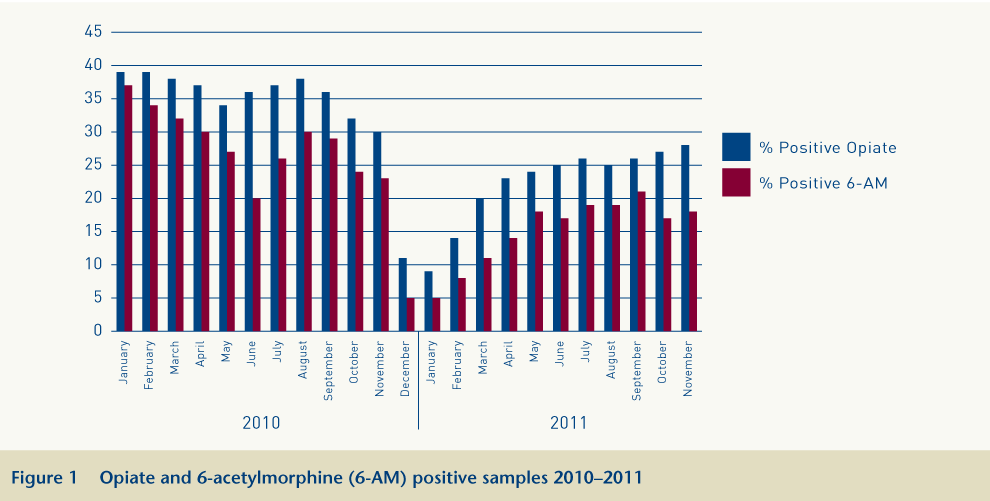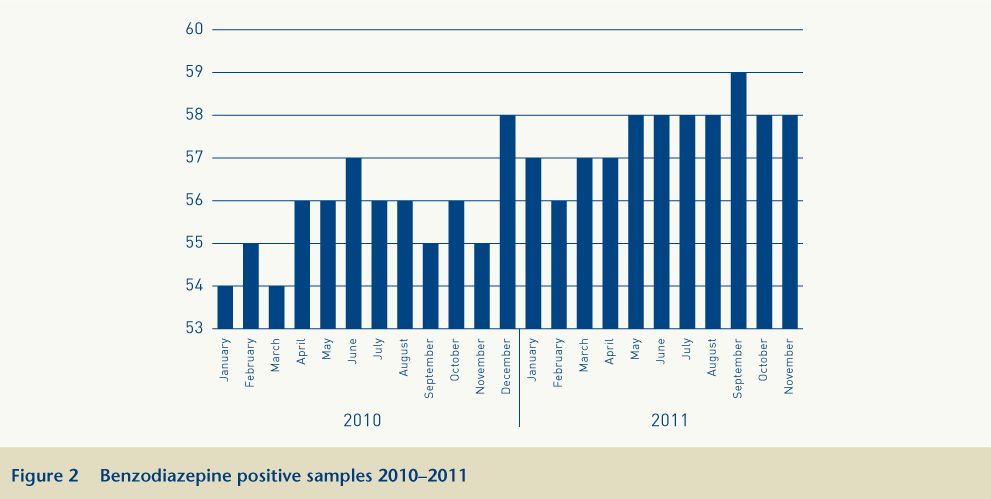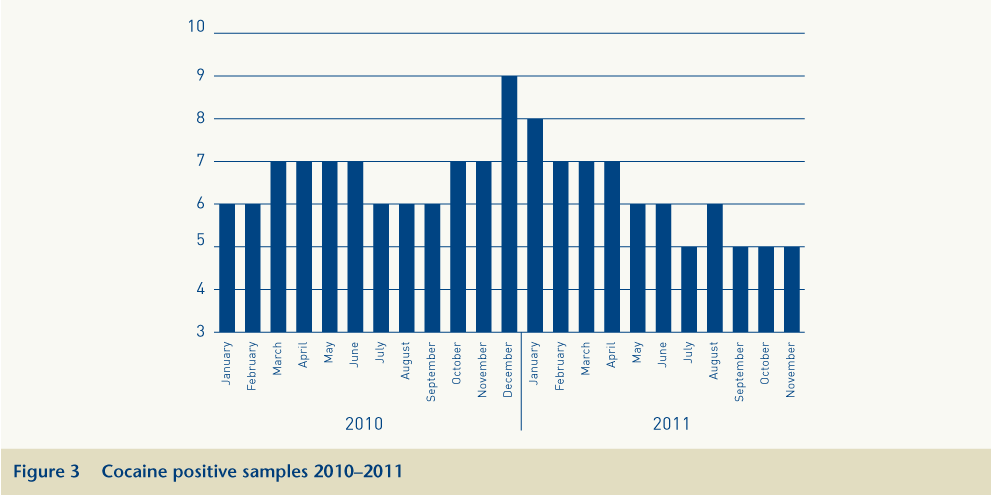The Drug Treatment Centre Board (DTCB) laboratory provides a nationwide service to the HSE Addiction Services, hospitals, general practitioners, voluntary organisations, the Department of Education (juvenile detention centres), the Probation Service, the Courts Service, the Medical Council, an Bord Altranais and occupational health departments. The Laboratory is accredited by the Irish National Accreditation Board (INAB) to ISO/IEC 17025 standard (INAB scope 169T).
The percentage of samples testing positive for drugs gives a quantitative measure of the extent of their use. With its large sample throughput, the DTCB laboratory is ideally placed to monitor trends in the prevalence of drugs in the drug-using population.
6-acetylmorphine (6-AM) is used as a marker for heroin use, being a unique metabolite only present when heroin has been taken. From 2005 to 2009, samples testing positive for 6-AM increased significantly, reaching an average of 29% in 2009. Samples testing positive for opiates followed a similar pattern. The data demonstrated a significant increase in the use of heroin in Ireland over this period.
A HRB paper on trends in treated opiate use1 noted a 20% increase in the number of opiate cases presenting to drug treatment services between 2002 and 2007. In 2007 11,392 cases were treated for opiate use (mainly heroin) and three out of five people entering treatment cited an opiate as their main problem substance.
According to the European Monitoring Centre for Drugs and Drug Addiction (EMCDDA), heroin still accounts for the greatest share of morbidity and mortality related to drug use in Europe.2 A decline in heroin use and associated problems was observed in the late 1990s, however from 2003-04 the trend became less clearly defined. Our data showed increased use of heroin between 2005 and 2009.
According to the UN Office on Drugs and Crime World drug report 2011, Ireland has the highest drug-related mortality rate in the EU and the third highest in the whole of Europe. The primary cause of poisoning deaths in Ireland was heroin and other opiates (such as methadone and codeine).
Polysubstances were found in 61% of all deaths by poisoning in 2008as recorded by the National Drug-Related Deaths Index.3 Heroin, methadone and other opiates (unspecified opiates and analgesics containing opiates) were implicated in 32.3%, 29.3% and 22.5% respectively of all cases. Benzodiazepines were found in 38.0% of all cases and played a major role in polysubstance deaths, being involved in more deaths by poisoning than any other substance in the period 1998–2008.
In November 2010 a heroin ‘drought’ was reported in the UK.4 The report stated that hospitals were treating a growing number of drug users who had overdosed on heroin mixed with other substances. Concerns were expressed that what was being sold as heroin appeared to be adulterated with a powerful sedative and mixed with a high percentage of bulking agents like talcum powder or paracetamol.
This UK report was followed by anecdotal reports of a similar heroin drought in Ireland. A warning was issued to users on the website drugs.ie.5 The Irish Needle Exchange Forum website also warned of the dangers of overdose, lowered tolerance and other health risks.6 According to the INEF, the poor quality of the heroin available led some users to switch from smoking to injecting, and to use of 2.5ml needles to overcome the tendency of the contaminated heroin to congeal in 1ml needles, thus increasing overdose risk.
Study of the percentages positive of 6-acetylmorphine(6-AM) in samples tested over this period shows a very sudden decrease in positive samples in December 2010 (Figure 1), giving quantitative evidence of the extent of the drought in Ireland at this time, since heroin is the main drug of choice of the population being tested. This reduction in 6-AM positive samples is tracked closely by a similar decrease in opiate positive samples (as would be expected).

Looking at the data in 2011, it is clear that, while there has been some recovery in supply of heroin since January, there is still a significant reduction in the 6-AM positive samples. Only 18% of the samples tested in November 2011 were 6-AM positive, as compared to 37% in January 2010. Opiate positives also decreased, from 39% to 28%.
Our data indicate that either the availability of heroin is significantly reduced currently or the heroin available in the market at this time is lower in strength than that normally available, thus giving rise to fewer positive samples.
In February 2011 three overdose deaths occurred in Kilkenny, followed by three deaths in Dublin. The overdoses were reportedly the result of batches of ‘high quality’ heroin coming into circulation following a heroin ‘drought’ over Christmas and the new year.7 However, in March 2011 fears were raised that the heroin involved in the six deaths had been mixed with benzodiazepines.8

A significant increase in benzodiazepine use has occurred since 2005. Benzodiazepine positive samples increased from 51% in 2005 to an average of 56% in 2010. Benzodiazepine positive samples spiked in December 2010, coinciding with the heroin drought (Figure 2). There is an ongoing increase in benzodiazepine positive samples (averaging 58% currently). This may reflect market response to an ongoing reduction in heroin availability or strength by increased use of benzodiazepines as a substitute.
The extent to which this increase could be due to heroin being ‘cut’ or substituted with benzodiazepines is unknown. These drugs are also sold to a significant extent in the illicit drug market. In 2010 the Irish Medicines Board seized 822,484 units of counterfeit medicinal products, of which 153,483 units were sedatives, including diazepam, zopiclone and flurazepam.9
Unfortunately, it is difficult to quantify the extent of the increase in use of benzodiazepines, as a large proportion of the drug-using population are prescribed benzodiazepines, and increased illicit use in this cohort will not necessarily be reflected in the figures.
There was also a temporary peak in cocaine use at the time of the heroin drought in December 2010, when apparently it was being used as an alternative to heroin (Figure 3) but positive samples have now returned to the level seen prior to the heroin drought.

According to an article in Druglink,10 unpublished figures from the UK Forensic Science Service showed that the average purity of street heroin there was at an all-time low of 13.1% in January 2011 (from an average purity of 30–40%). Increased use of black market diazepam was feared to have been responsible for a number of deaths in Cardiff. Possible causes of the heroin drought cited included fungal blight of the poppy crop, recent law enforcement operations disrupting the supply network, stockpiling by wholesalers to increase the price or diversion of supply to an easily accessed and growing Russian market. If the reason for the drought is one of the last, it could have a more long-term impact on the situation.
The first EMCDDA Trendspotter meeting in October 2011 on ‘Recent shocks in the European heroin market: explanations and ramifications’11 found that a small number of countries including Ireland experienced a severe shortage of heroin most heavily felt between November 2010 and March 2011. Divergent situations existed in Europe and the reasons for the drought were multifaceted. In areas where heroin drought was experienced drug users were reportedly increasing use of both alcohol and non-prescribed benzodiazepines to fill the vacuum.
The heroin drought seems to have had an ongoing impact on heroin supply in Ireland as heroin use continues to be down on previous figures. However, this has been counterbalanced by an increase in benzodiazepine use. The significant rise in benzodiazepine use is worrying considering their role in polysubstance deaths, although perhaps this may be mitigated by the corresponding decrease in heroin use which seems to have occurred. The effect of the heroin drought in terms of mortality among drug users will only evolve over time.
(Siobhán Stokes, Principal Biochemist, DTCB laboratory)
1. Carew AM, Bellerose D, Lyons S and Long J (2009) Trends in treated problem opiate use in Ireland, 2002 to 2007. HRB Trends Series 7. Dublin: Health Research Board. https://www.drugsandalcohol.ie/12371  ORCID: https://orcid.org/0000-0003-2406-0879
(2012)
Quantitative evidence of a heroin drought.
Drugnet Ireland,
Issue 40, Winter 2011,
pp. 21-23.
ORCID: https://orcid.org/0000-0003-2406-0879
(2012)
Quantitative evidence of a heroin drought.
Drugnet Ireland,
Issue 40, Winter 2011,
pp. 21-23.


